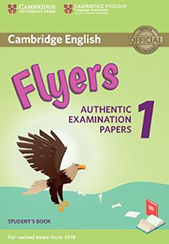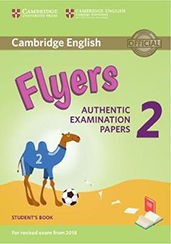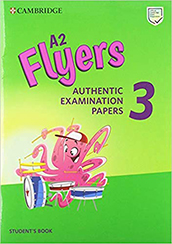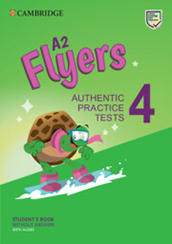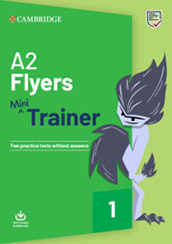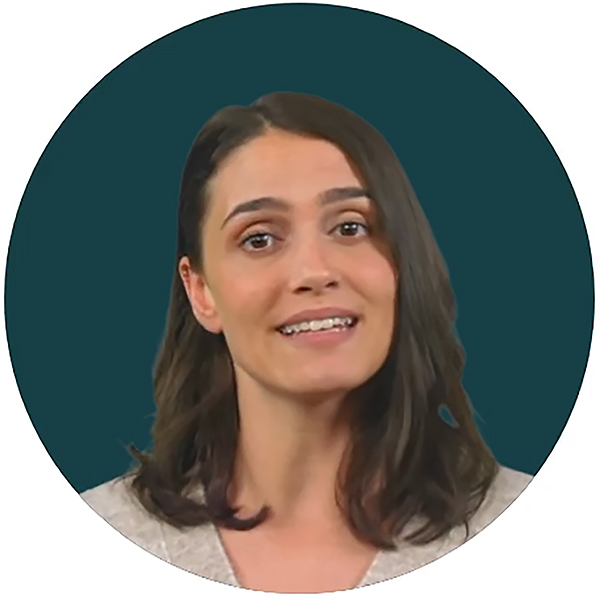The tests Cambridge English: Young Learners, also known as Young Learners English (YLE), measure how well 7–12 year–olds perform in the skills of listening, speaking, reading, and writing. Tests are designed to make learning fun and encourage children to work towards certificates and earning ‘shields’ that record their progress.
A2 Flyers, also known as YLE Flyers, is the highest of three tests specifically designed for schoolchildren aged 7 to 12. A2 Flyers shows that a child can deal with everyday written and spoken English at a basic level. As learners develop and work their way up to the Flyers certificate, they reach a level that will enable them to take the A2 Key (KET) for Schools or B1 Preliminary (PET) for Schools – exams which lead to certificates internationally accepted for work and study purposes.
PAPER 1: Listening
Duration: about 25 minutes
Number of parts: 5 parts
Number of questions: 25 questions in total
Marks: a maximum of five shields
Part 1 (5 questions)
A big picture which shows people doing different things. Above and below the picture, there are some names. Candidates have to listen carefully to a conversation between an adult and a child and draw a line from each name to the correct person on the big picture.
Part 2 (5 questions)
A short conversation between two people. There is a form or a page of a notebook with some missing words (gaps). Candidates have to listen to the recording and write a missing word or number in each gap.
Part 3 (5 questions)
Two sets of pictures. On the left, there are some pictures of people and their names, or other named places or objects. On the right, there is a set of pictures with letters but no words. Candidates have to listen to a conversation between two people and match each of the pictures on the right to one of the named pictures on the left.
Part 4 (5 questions)
Five short conversations. There is a question and three pictures for each conversation. Candidates have to decide which picture shows the right answer to the question and put a tick in the box under it.
Part 5 (5 questions)
A big picture. Candidates have to listen carefully to a conversation between an adult and a child and colour (black, blue, brown, green, grey, orange, pink, purple, red, yellow) different objects in the picture using the color they say in the conversation. Candidates will also have to write a word as part of this question.
PAPER 2: READING & WRITING
Duration: 40 minutes
Number of parts: 7 parts
Number of questions: 44 questions in total
Marks: a maximum of five shields
Part 1 (10 questions)
Fifteen words and ten definitions (sentences that describe or explain ten of the fifteen words). Candidates have to write the correct word next to each definition.
Part 2 (5 questions)
A short conversation between two people. Everything that the first speaker says is printed on the question paper, with gaps for the second speaker’s answers. For each gap, candidates have to choose the correct answer from a list (A-H).
Part 3 (6 questions)
A text with some missing words (gaps) in it. Each gap represents a missing word (a noun, adjective or verb). Next to the text there is a box with words in it. Candidates have to choose the correct word from the box for each gap and copy it. For the last question, candidates have to choose the best title for the text from a choice of three possible titles.
Part 4 (10 questions)
A text with some missing words (gaps). Next to the line where each word is missing, there is a choice of three possible answers. Candidates have to decide which answer is correct and copy the word into the gap.
Part 5 (7 questions)
A complete story, and seven sentences about the story. Each sentence has a gap which candidates have to complete using one, two, three or four words.
Part 6 (5 questions)
A text from a letter or diary with five gaps. Children have to write the missing word in each of the five gaps. There is no list of words to choose from.
Part 7 (1 part)
Three pictures which tell a story. Candidates have to write about this story using 20 or more words.
PAPER 3: SPEAKING
Duration: 7-9 minutes
Number of parts: 4 parts
Marks: a maximum of five shields
Part 1
The examiner greets the candidate and asks their name, surname and age. The examiner shows the candidate two pictures, an examiner’s picture and a candidate’s picture. Both pictures are similar but they have some differences. The examiner then makes a series of statements about the examiner’s picture and the candidate has to respond by making statements showing how the candidate’s picture is different, e.g. (examiner) ‘In my picture, the man is pointing at a cloud on the map.’ (candidate) ‘In my picture, he’s pointing at the sun.’
Part 2
The child and the examiner each have two similar pictures (for example, pictures of two different restaurants). The examiner has information about one picture, and the child has information about the other picture. The examiner first asks the candidate questions related to the information the candidate has, e.g. ‘What’s the name of Robert’s favourite restaurant?’ and the candidate answers. The candidate then asks the examiner questions, e.g. ‘What’s the name of Sarah’s favourite restaurant?' and the examiner answers.
Part 3
The examiner shows four pictures and tells the candidate the name of the story and describes the first picture, e.g. ‘These pictures tell a story. It’s called “The Brave Teacher”. Just look at the pictures first. (pause) Nick and Anna are looking out of the classroom window. The teacher isn’t happy because they’re not doing their work.’ The examiner then asks the candidate to continue the storey and describe the other three pictures. The title of the story and the name of the main character(s) are provided.
Part 4
The examiner asks the candidate personal questions on topics such as school, hobbies, birthday, family or holidays.
Register online for your exams through ORFEAS, our online registration system. Find an examination center close to home from a choice of 100 locations throughout Greece and abroad, and complete your application online with your debit, pre-paid or credit card.
You will receive all the details for your upcoming exam via email in a single document that you can save, print and take with you on the day of your test. You will also be sent updates on the status of your application and useful support materials. Expect invitations to webinars for tips and strategies that will help you prepare effectively for the exam.
The ORFEAS registration system does away with print application forms and visits to the bank. Start and complete your registration online in a few simple steps. Use your home computer, tablet or smartphone to apply for your exam.
The A2 Flyers certificate celebrates children’s achievement, builds their confidence and rewards their ability in the use of the English language.
There is no pass or fail score in the results of A2 Flyers. All children receive a certificate which shows how well they performed in each part of the test by the number of shields they have received, out of a maximum of five.
A result of one shield means a child can improve in that skill while five shields mean that most of the questions were answered correctly. Candidates who receive 4 or 5 shields in each skill are ready to start preparing for the next Cambridge English exam, A2 Key for Schools.
The back of the the certificate shows how results align to the CEFR. The following factsheet can be used as a guide to help teachers and candidates understand how Cambridge English scale works. This information is better applied when using official Cambridge English practice tests.
How can I apply?
Use this link to enter the ORFEAS online registration system. From there, follow the steps as suggested. Choose your exam, date and venue and then provide your personal details. In the last step you will be asked to pay with your card of choice. All the information you will need for the day of the exam will arrive in your inbox via email and SMS.
What if I have a question about the procedure?
If you have any questions about the procedure, even as you complete the steps in the process, contact us on 2103680000 for assistance. We have staff available from 9 am - 7 pm on weekdays to help you complete the registration process and answer your questions.
Can I see the status of my registration after I have applied?
Once you complete your registration you will be sent updates on the status of your application. For example, any changes to the date of the examination, if these occur, will be communicated to you via email, SMS or telephone by our support team.
Schedule
| Exam Date: | Exam Administration: | Test Centers: | Registration Period: |
|---|---|---|---|
|
|
|
Registration Period:
|
Support
Find useful information for your exams or existing certifications, tips and advice, free preparation material and more.

